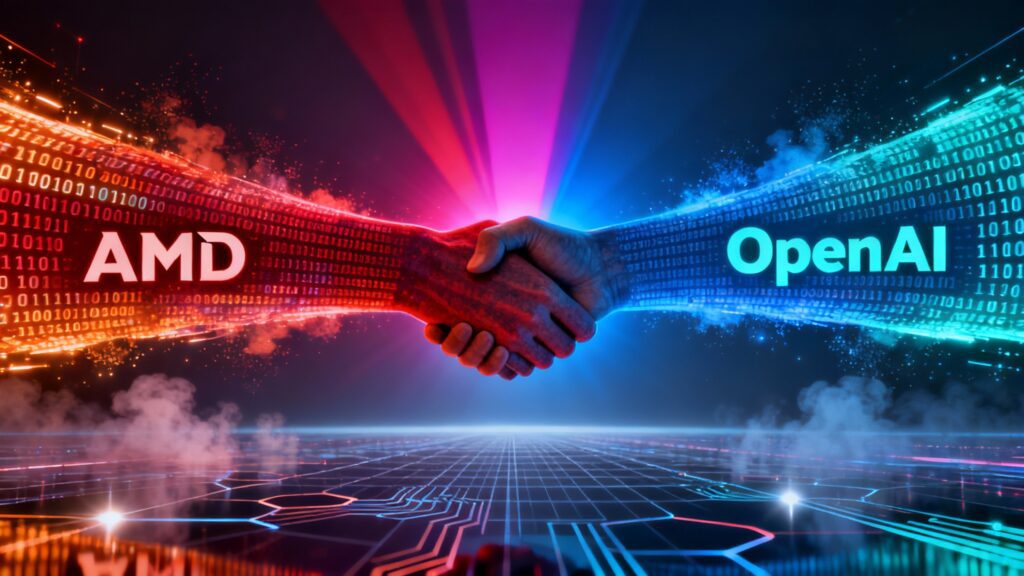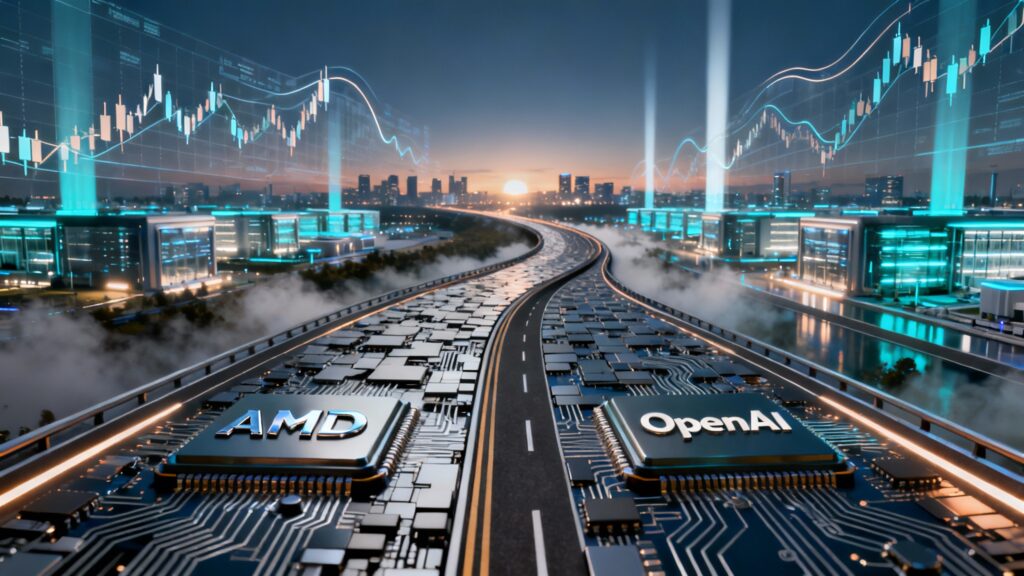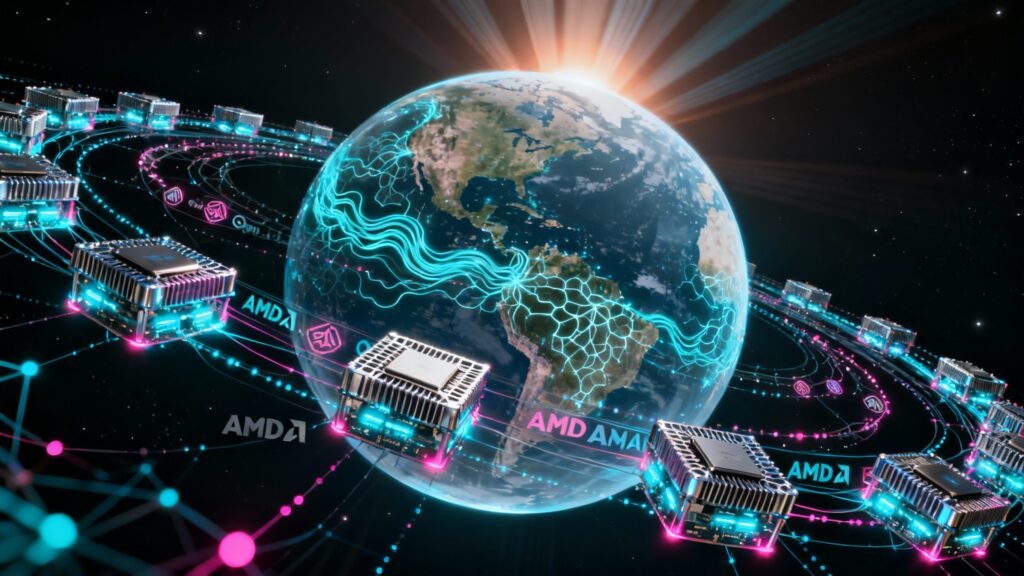
In a move poised to reshape the AI hardware landscape, OpenAI and AMD have unveiled a sweeping partnership that will see AMD supply six gigawatts of its Instinct GPUs to power OpenAI’s next-generation infrastructure. (Advanced Micro Devices, Inc.) The first deployment—one gigawatt worth of the upcoming MI450 series—is slated to begin in the second half of 2026. (Advanced Micro Devices, Inc.)
The agreement is structured as a multi-year, multi-generation arrangement—OpenAI will adopt the MI450 GPUs first, then subsequent AMD generations—and includes a unique equity component: AMD is issuing OpenAI a warrant to acquire up to 160 million shares of AMD stock. (Advanced Micro Devices, Inc.) Those warrants vest in tranches aligned with deployment milestones and share-price targets. (Advanced Micro Devices, Inc.)
From the perspective of both firms, this is more than a supplier agreement. It cements AMD’s role as a core compute partner in this next wave of AI development. As OpenAI scales its infrastructure, AMD expects “tens of billions” in revenue over the term, while both sides see deep technical alignment and mutual strategic incentives. (Advanced Micro Devices, Inc.)
This announcement comes at a time when the AI compute arms race is accelerating rapidly—the cost, complexity, and scarcity of high-end accelerators are among the top constraints for ambitious AI efforts worldwide.
Technical & Financial Architecture of the Deal
Scaling at Gigawatt Scale
The scale of this agreement is striking: six gigawatts of GPU power is not a casual commitment. For context, a single gigawatt is comparable to the output of a medium nuclear or large power plant. (Investopedia) OpenAI plans to kick off with one gigawatt of MI450s in 2026, then ramp toward full deployment in subsequent years. (Advanced Micro Devices, Inc.)
Operating at that scale requires coordination across chip design, cooling, power delivery, physical data center capacity, and software stack integration. The deal makes room for rack-level AI solutions, co-engineering, and close collaboration to optimize deployments. (Advanced Micro Devices, Inc.)
Milestones, Warrants & Incentives
AMD’s issuance of warrants to OpenAI is a clever alignment mechanism. The first tranche vests when OpenAI deploys its initial gigawatt; subsequent tranches hinge on further scale, performance benchmarks, and AMD achieving certain share-price thresholds. (Advanced Micro Devices, Inc.)
If fully vested, those 160 million shares could give OpenAI roughly 10 % of AMD’s equity, depending on share count and dilution. (AP News) This is a rare structure in chip supply deals—OpenAI isn’t just a customer; it effectively becomes a stakeholder in the success of AMD’s AI business.
Beyond the warrants, AMD expects the revenue from this deal to be “tens of billions” over the term, with the potential to generate over $100 billion in incremental revenue in four years when including spin-off deals with other AI customers. (Reuters)
Nonexclusivity & Risk Sharing
It is worth noting that the agreement is non-exclusive. AMD retains freedom to work with other customers in the AI space. (Advanced Micro Devices, Inc.) For OpenAI, this deal is part of a broader strategy to diversify its compute supply beyond NVIDIA, which currently dominates the AI accelerator market. (AP News)
However, even nonexclusive deals carry risk. If AMD faces manufacturing delays, yield issues, or competitive pressure, OpenAI’s ramp could be jeopardized. The warrant structure helps mitigate by tying the upside to shared success.
Market Reaction & Strategic Implications

Stock Surges & Market Response
News of the deal triggered a dramatic reaction in the markets. AMD shares jumped—by as much as 25–30 % in pre-market and intraday trading. (AP News) Analysts quickly interpreted this as a validation of AMD’s AI roadmap and a shift in investor sentiment. (Reuters)
Investors viewed the partnership as a credible counterweight to NVIDIA’s dominant position. The scale of compute committed, combined with equity upside, suggested AMD might emerge as a more serious force in AI hardware. (Investopedia)
Meanwhile, NVIDIA stock felt mild pressure on the news—some investors speculated that OpenAI might shift portion of compute demand away. (Reuters)
AI Industry & Competitive Dynamics
This deal underscores how voracious demand for compute is fueling new alliances and escalating hardware bets. OpenAI is already working with NVIDIA (including a recent $100 billion compute arrangement) and designing its own silicon with Broadcom. (Reuters)
By bringing AMD in as a major compute partner, OpenAI reduces risk from overdependence on one vendor. It also injects healthy competition into the AI chip space—which may drive performance, pricing, and innovation.
From AMD’s side, this deal gives them a marquee AI customer, boosts credibility, and potentially opens doors to further deals in hyperscale AI, cloud providers, and research labs.
Ecosystem & Broader Ripples
The partnership tightens ties along the full AI stack: chip makers, system integrators, software tooling, data centers. Other AI players may follow suit with similar multi-generation commitments.
One key beneficiary: the broader AMD ecosystem—partners who build servers, motherboards, power supplies, cooling systems, AI software layers, and system architectures. As AMD chips scale, those ancillary markets may see lift.
There’s also a geopolitical angle. AI compute is central to national competitiveness, scientific research, defense, and industrial AI. Strategic alignments in chip supply carry importance beyond profits; supply chain resilience, export controls, and national security all hover in the background.
Challenges & Risks Ahead
While the headlines are bold, execution will be difficult.
Fabrication, Yield, and Supply Constraints
AMD must deliver reliable, high-performance GPUs at extreme volume and quality. Any yield drops, bottlenecks in manufacturing, or material shortages will ripple into deployment delays.
Given lead times, ramping to gigawatt scale demands years of planning in silicon design, packaging, cooling, and integration.
Thermal, Power & Infrastructure Scaling
AI chips consume massive energy. Deploying gigawatts of compute must be matched with power delivery, cooling systems, energy infrastructure, and data center capacity. OpenAI must build or retrofit data centers capable of support.
Any miscalculation—insufficient cooling, budget overruns, power failures—could slow down the build-out.
Competitive Pressure & Alternate Paths
OpenAI still works with NVIDIA, and it is developing its own custom silicon (with Broadcom). (AP News) If NVIDIA or other rivals innovate faster, the value of AMD’s offering could shrink.
Moreover, the nonexclusive nature means AMD must maintain competitiveness in price, performance, and reliability—even as it balances demands from other customers.
Warrant & Equity Risks
The value of the warrants depends heavily on milestone attainment and stock performance. If AMD fails to hit certain targets or OpenAI’s deployment pace slows, those warrants may not vest fully.
Furthermore, aligning two large organizations over multiple years is inherently tricky—goals may diverge, assumptions may change, and macroeconomic or regulatory shifts may intervene.
Why This Deal Matters
Signaling a Shift in AI Compute Strategy
This deal is a signal: OpenAI is no longer content to lean on a single hardware vendor. It’s placing a bet on diversity, modularity, and future options. In effect, it’s hedging its compute strategy for the next decade of AI scaling.
Validating AMD’s AI Ambitions
AMD has long sought to compete with NVIDIA in AI and data center chips. This contract elevates AMD from underdog to serious contender. The deep technical tie-ins, co-design, and equity incentives help anchor AMD’s AI ambitions in real deployments.
Driving Compute Supply at Scale
One of the biggest constraints in AI today is compute availability: hardware supply, production bottlenecks, and cost. Deals of this scale help push the ecosystem toward greater capacity, which in turn opens pathways for more ambitious models, more training iterations, and broader AI application deployment.
Raising the Stakes in the AI Arms Race
When companies commit to gigawatt-scale compute agreements, the bar for competition rises. Others must match or exceed. R&D cycles accelerate. Partnerships deepen. The ecosystem becomes more entrenched and capital-intensive.
In short: this is not just a supplier contract. It’s a declaration of strategic intent, a battlefield marker in the AI hardware war.
Timeline & Outlook
Here’s how the next few years might play out:
- 2026, H2: First 1 GW deployment of MI450s. That’s the first milestone when OpenAI’s first tranche of warrants vests. (Advanced Micro Devices, Inc.)
- 2027–2029: Ramp deployments across subsequent GPU generations up to the full 6 GW commitment. Warrant tranches vest as compute and share-price milestones are met.
- Mid/late term: AMD expects to start recognizing substantial revenue and profit from this deal. For OpenAI, this co-investment establishes a long-term compute backbone that supports new AI capabilities.
- Beyond 2030: Depending on the success of the deal and market dynamics, OpenAI may hold a meaningful stake in AMD, further blurring the line between customer and investor.
If execution goes smoothly, this could become one of the most consequential hardware deals in AI history.
What Observers Are Saying
Some tech analysts call the deal transformative. AMD’s executive vice president Forrest Norrod described it as such, noting that it may shift the industry’s trajectory. (Reuters) Others see it as a validation of AMD’s AI roadmap, turning years of anticipation into a marquee win. (AP News)
OpenAI President Greg Brockman stated plainly: “We need as much computing power as we can possibly get.” (Business Insider) That sense of compute urgency underscores the rationale behind such a large commitment.
Some skeptics point to the challenges ahead: supply chain constraints, architectural mismatch, the risk of being outpaced by rivals, and the sheer complexity of maintaining coherence across such long time horizons.
Nevertheless, the momentum is with those who can deliver at scale—and for now, AMD has secured a starring role in that narrative.
Broader Implications: AI, Tech, & Power

Democratizing Access to Compute?
If AMD scales effectively, it might help lower entry barriers for AI firms beyond just the hyperscale players. Increased supply, competition, and broader availability could drive down costs and diversify innovation beyond the biggest labs.
National Strategy & Supply Chain Security
Governments are paying attention to compute sovereignty, chip supply chains, and the risks of vendor concentration. Deals like this may spur policies around semiconductor fabrication, export controls, and domestic AI infrastructure funding.
Innovation Up the Stack
With a reliable backbone, OpenAI and others may push forward more aggressive model experiments, increased retraining cadence, more energy-intensive research, and previously impractical architectures. The compute bottleneck might loosen slightly—though power, cooling, and cost constraints will still loom.
Competitive Pressures & Consolidation
Rivals will scramble. NVIDIA will push harder. Other chip makers (Intel, ARM, smaller AI accelerator startups) may double down on differentiation (e.g., performance per watt, domain-specific accelerators). Consolidation in the AI hardware niche may accelerate.
Final Thoughts
This AMD–OpenAI partnership is more than a headline—it’s a tectonic shift. At six gigawatts of committed compute, with equity incentives and multi-generation alignment, it’s as much a strategic alliance as a supply contract.
If both sides execute well, this could redefine how AI systems are built, how hardware firms scale, and how compute is provisioned globally. It’s a bold bet, one with high risks and even higher rewards. The world will be watching.
Sources
- AMD and OpenAI Announce Strategic Partnership to Deploy 6 Gigawatts of AMD GPUs – AMD Press Release (HPCwire)
- AMD Soars After Striking Major Deal with OpenAI – WallStreetPit
- OpenAI Wants to Buy Millions of AMD Accelerators – Heise Online
- AMD Signs a Long-Term Deal to Supply OpenAI with Multiple Generations of Instinct GPUs – The Decoder
- OpenAI–AMD Strategic Partnership Announcement – OpenAI Official Blog
- AMD and OpenAI Five-Year AI Chip Agreement – The Verge
- AMD Signs AI Chip-Supply Deal with OpenAI, Gives It Option to Take 10% Stake – Reuters
- OpenAI and Chipmaker AMD Sign Chip Supply Partnership for AI Infrastructure – AP News
- OpenAI and AMD Announce Massive AI Partnership, Sending AMD Shares Soaring – Investopedia
- OpenAI Signs Multibillion-Dollar Chip Deal with AMD – The Guardian










Comments 2